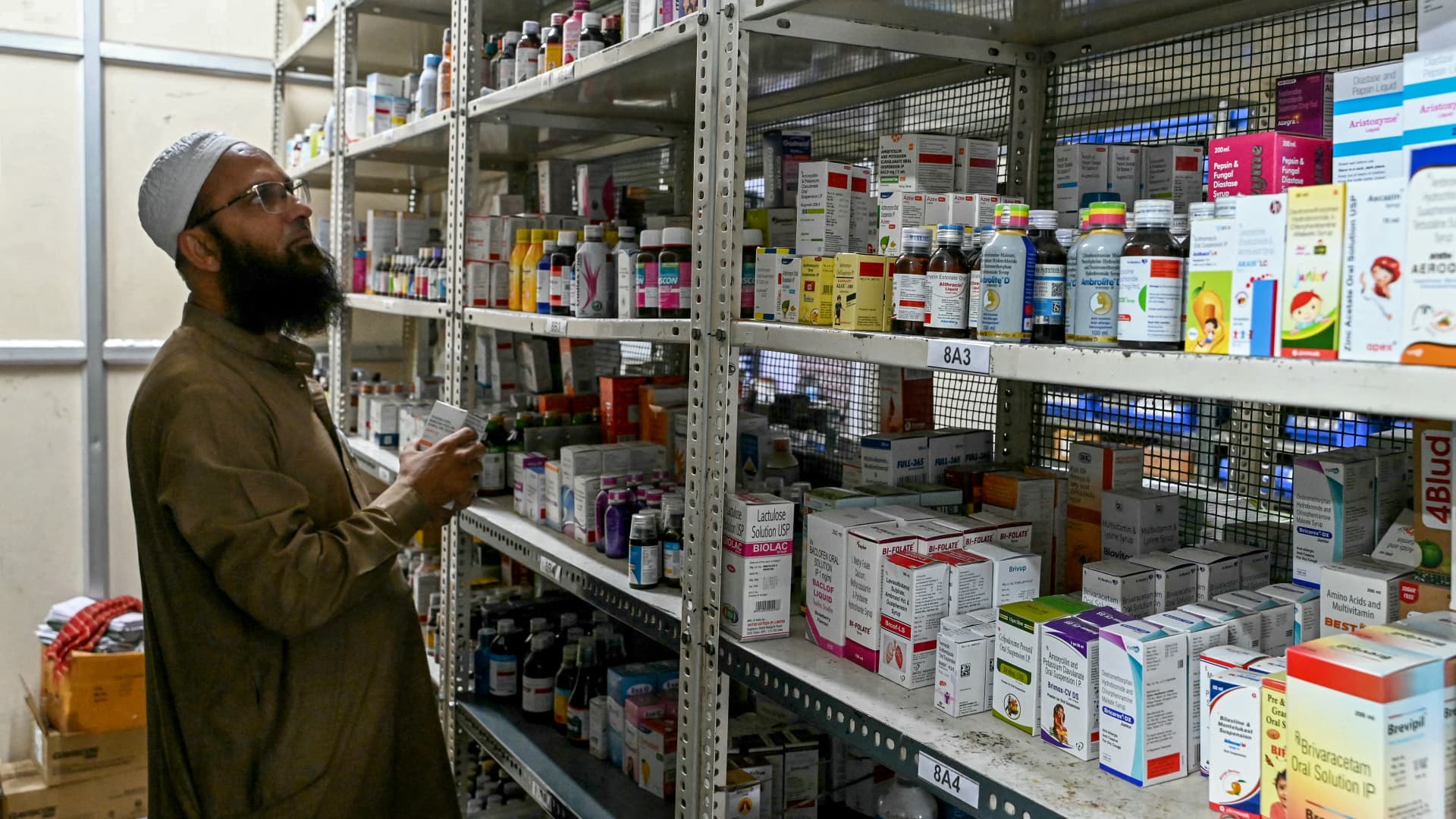An employee checks the stock of medicines at a pharmacy store in Hyderabad on July 31, 2025.
Noah Seelam | Afp | Getty Images
India’s exports to the U.S. face a steep 50% tariff after U.S. President Donald Trump on Wednesday slapped an additional 25% duty on Indian goods over the country’s oil purchases from Russia.
The extra duties — set to come into effect within 21 days — will be stacked on top of the 25% tariffs on New Delhi due Thursday stateside, according to the executive order.
Analysts are warning that the higher U.S. tariffs risk substantially diminishing the allure of Indian exports to the U.S., compared to regional peers.
“India’s attractiveness as an emerging manufacturing hub will be hugely undermined,” Shilan Shah, deputy chief emerging markets economist at Capital Economics, said in a note. He estimates that the U.S. spending drives around 2% of India’s GDP and the extra 25% tariff is “large enough to have a material impact.”
India counts the U.S. as its single largest export partner. Its total goods’ exports reached about $434 billion in the year ended March 2025, and nearly 20%, or $86.51 billion worth of goods were shipped to the U.S., according to the latest official data.
The resulting drop in exports due to tariffs would mean the economy grows by closer to 6% this year and next, rather than the 7% growth forecast prior to Trump’s announcement, Shah said.
The potential 50% extra tariff on Indian products could put a drag of a total 0.6 percentage point on its GDP, according to Goldman Sachs’ estimates.
India’s major exports to the U.S. are engineering and electronic goods, drugs and pharmaceuticals, gems and jewelry, according to the government data.
With notable variance across industries and little clarity over Trump’s plans with sector-specific tariffs, here are segments that potentially stand to lose the most:
Engineering goods
Engineering goods, including products like auto parts, power equipment and industrial machinery, have been India’s biggest of exports to the U.S. and globally, hitting nearly $117 billion in the year ended March.
Around 19.16 billion worth of these industrial goods, or about 16%, were sold to the U.S. over that period.
Exports of iron, steel, and other products exports accounted for 17.07% of the total engineering exports, while non-ferrous metals and products exports contributed 10.52%. Steel exports already face 50% sectoral tariffs, worsening the outlook for the sector as the same levy now looms large on its other segments.
India’s total goods exports jumped 1.92% in June, in part driven by the rise in engineering goods, which rose 1.35% to $9.5 billion.
Gems, jewelry, textiles and apparels
The gems and jewelry, and textiles and apparels sectors, are also expected to be significantly jolted by the sudden hike in U.S. tariffs.
The gems and jewelry sector contributes 7% of India’s GDP and employs about 5 million workers, according to a July report by a state-backed industry body.
About 33% of India’s gems and jewelry exports went to the U.S. in fiscal year 2025.
Rajesh Mehta, executive chairman of Indian jewelry maker Rajesh Exports, said in an interview with CNBC Wednesday that higher tariffs will be an “additional burden,” while calling for government support for the sector.
Textiles is among the most labor-intensive sectors in India, directly employing about 45 million workers across the country. Similar to gems and jewelry, around 34% of textile exports went to the U.S. in the last fiscal year.
“Without a doubt, the new tariff rate is going to seriously test the resolve and resilience of India’s textile and apparel exporters as we will not enjoy a significant duty differential advantage vis-à-vis many other countries, except Bangladesh, with whom we compete for a larger share of the US market,” the Confederation of Indian textile industry said in a statement dated July 30, before the latest hike in duties was announced.
Electronics
India’s electronics sector relied on the U.S. for 38% of its exports last fiscal year, making it “the most exposed” to potential risks of the tariff exemptions being rolled back, according to Alexandra Hermann, lead economist at Oxford Economics.
India overtook China to become the top exporter of smartphones sold in the U.S. in the second quarter, after Apple accelerated to move its assembly of more iPhones to the South Asian nation.
In a major, although temporary, reprieve for companies such as Apple, Trump in April announced to exempt smartphones, computers and other electronic goods from tariffs.
India’s U.S.-bound exports of electronic goods have accelerated this year, and its exports in March alone more than doubled to $2.76 billion from a year earlier.
Pharmaceuticals
While the pharmaceutical sector is also currently exempt from tariffs, Trump has threatened duties on pharma exports to the U.S. In an interview to CNBC Trump said he would initially impose a “small tariff” on pharma, and then raise that rate to as high as 250% in a few years.
India’s pharma sector has a high dependency on U.S. buyers, with its drugs and pharma exports to the U.S. reaching over $10.5 billion for the year ended March 2025, accounting for nearly 35% of the category’s total shipments, according to the official data.
“[India’s] Chemicals overall have somewhat less US exposure but this masks the high pharmaceutical sector’s US dependency therein,” said Hermann, leaving the pharma sector highly vulnerable to Trump’s potential tariffs.
India also exported steel and aluminum to the United States, but trade in those goods is taxed through a separate executive order.
Overall competitiveness
“The U.S. could more easily source for supplies from alternative import locations, but it is much harder for India to diversify away from the U.S. across different sectors,” said Michael Wan, senior economist at MUFG Bank.
India competes against the likes of Europe in pharmaceuticals; Vietnam and Mexico in electronics; Cambodia, Sri Lanka, Bangladesh and Vietnam in textiles; and Israel in gems and jewelry, according to Wan. “If these tariff differentials stick, India’s export competitiveness will likely be eroded over time,” he said.
Among the export-reliant nations that have clinched preliminary deals with Trump, Vietnam saw its tariffs lowered to 20% from 46%. In his latest tariff adjustment, Trump also eased tariffs on Thailand to 19% from the “reciprocal” tariff level of 36%, Bangladesh to 20% from 35% and Cambodia to 19% from 36%.
Around 32% of India’s exports to the U.S. are currently exempt from tariffs, according to MUFG’s estimates, including electronics and pharmaceutical products.





